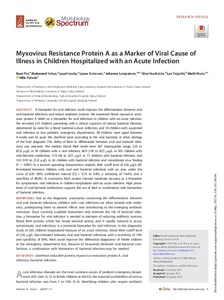Myxovirus Resistance Protein A as a Marker of Viral Cause of Illness in Children Hospitalized with an Acute Infection
Tripathi Lav; Lempainen Johanna; Toivonen Laura; Waris Matti; Yahya Mohamed; Peltola Ville; Ivaska Lauri; Nuolivirta Kirsi; Piri Ruut
https://urn.fi/URN:NBN:fi-fe2022081154088
Tiivistelmä
A biomarker for viral infection could improve the differentiation between viral and bacterial infections and reduce antibiotic overuse. We examined blood myxovirus resistance protein A (MxA) as a biomarker for viral infections in children with an acute infection. We recruited 251 children presenting with a clinical suspicion of serious bacterial infection, determined by need for a blood bacterial culture collection, and 14 children with suspected viral infection at two pediatric emergency departments. All children were aged between 4 weeks and 16 years. We classified cases according to the viral, bacterial, or other etiology of the final diagnosis. The ability of MxA to differentiate between viral and bacterial infections was assessed. The median blood MxA levels were 467 (interquartile range, 235 to 812) μg/L in 39 children with a viral infection, 469 (178 to 827) μg/L in 103 children with viral-bacterial coinfection, 119 (68 to 227) μg/L in 75 children with bacterial infection, and 150 (101 to 212) μg/L in 26 children with bacterial infection and coincidental virus finding (P < 0.001). In a receiver operating characteristics analysis, MxA cutoff level of 256 μg/L differentiated between children with viral and bacterial infections with an area under the curve of 0.81 (95% confidence interval [CI] = 0.73 to 0.90), a sensitivity of 74.4%, and a specificity of 80.0%. In conclusion, MxA protein showed moderate accuracy as a biomarker for symptomatic viral infections in children hospitalized with an acute infection. High prevalence of viral-bacterial coinfections supports the use of MxA in combination with biomarkers of bacterial infection.
Kokoelmat
- Rinnakkaistallenteet [19248]
